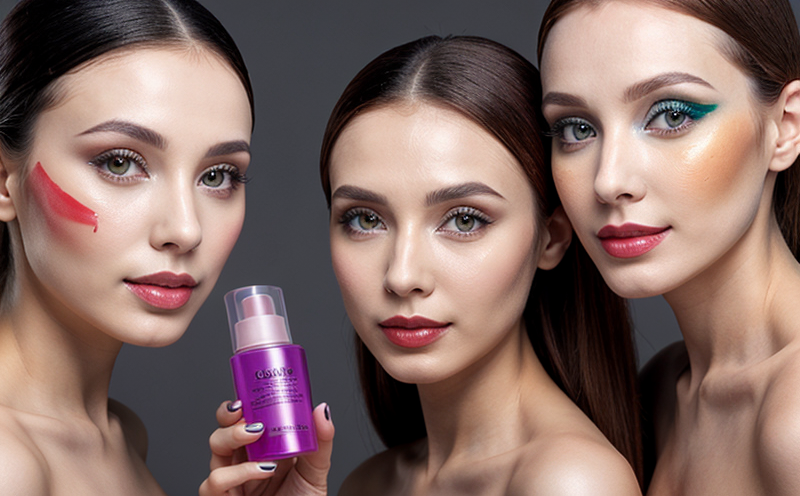In Silico Toxicological Assessment of Cosmetics
The in silico toxicological assessment of cosmetics is a cutting-edge approach that leverages computational models to predict potential adverse effects of cosmetic products before they reach the market. This method offers several advantages over traditional animal testing, including reduced costs, faster turnaround times, and increased ethical considerations.
Using sophisticated software algorithms and databases, in silico assessments can simulate the interaction between cosmetic ingredients and biological systems at various levels – from molecular to systemic effects. These simulations help identify potential risks early in the product development process, allowing companies to make informed decisions about ingredient selection and formulation adjustments.
The primary focus of this service is ensuring that new or reformulated cosmetic products do not pose significant health hazards when used as intended by consumers. By addressing safety concerns upfront, brands can enhance their reputation for responsible innovation while minimizing regulatory risks associated with non-compliance.
Our team employs state-of-the-art computational tools compliant with international standards such as OECD guidelines and ISO specifications to ensure accurate predictions of toxicological endpoints relevant to cosmetic use cases. This includes evaluating dermal irritation potential, skin sensitization risks, phototoxicity concerns, reproductive toxicity issues, developmental effects, and more.
For instance, when assessing a new sunscreen formulation, our specialists would analyze how its active ingredients behave under different conditions typical of actual consumer usage scenarios. They might simulate exposure routes like direct application onto intact or damaged skin, repeated daily applications over extended periods, varying light exposures if applicable, etc., all while considering individual characteristics such as age, gender, race, and underlying health conditions.
This comprehensive approach ensures that every aspect contributing to overall safety is accounted for. Additionally, it allows us to provide detailed reports outlining both positive findings (indicating safe use) as well as areas where further investigation may be necessary based on identified uncertainties or ambiguities within the model outputs.
By incorporating advanced machine learning techniques and big data analytics into our workflow, we stay at the forefront of this rapidly evolving field. Our commitment to continuous improvement allows us to adapt swiftly to emerging trends in regulatory requirements and scientific understanding.
In summary, an in silico toxicological assessment offers a robust solution for addressing safety concerns associated with cosmetic products early in their lifecycle. It not only supports compliance but also contributes significantly towards improving product quality by fostering safer formulations.
Quality and Reliability Assurance
To maintain high standards of accuracy and reliability, we adhere strictly to established methodologies approved by recognized bodies including OECD, ISO, and others. Our methodologies are designed to mimic real-world conditions as closely as possible while providing precise predictions about potential adverse effects.
We invest heavily in maintaining cutting-edge software tools and regularly update our databases with the latest research findings relevant to cosmetic products. This ensures that our assessments remain current and relevant throughout each stage of product development.
Our quality assurance processes include rigorous validation studies conducted independently by third parties who specialize in this area. These validations confirm that our models accurately reflect real biological responses across a wide range of scenarios considered pertinent to cosmetics testing.
Furthermore, we engage continuously with regulatory authorities and industry stakeholders to align our practices closely with evolving expectations regarding safety assessments for cosmetic ingredients and finished products. This proactive approach helps us stay ahead of changes in legislation or guidance documents that could impact how we perform these evaluations.
International Acceptance and Recognition
The in silico toxicological assessment has gained significant traction globally due to its advantages over conventional testing methods, particularly regarding regulatory acceptance. Many countries have recognized the value of this approach, and it is increasingly being incorporated into national regulations.
In Europe, for example, EU Directive 2013/53/EU emphasizes the importance of alternative methods like in silico assessments as part of efforts to reduce reliance on animal testing. Similarly, the US Food and Drug Administration (FDA) recognizes certain computational tools under its Guidance for Industry document titled “Alternatives to Animal Testing for Safety Evaluations of Cosmetics.”
Other regions such as Australia and New Zealand have also shown support for integrating in silico assessments into their respective frameworks. The Australian Government's National Contact Point for OECD Guidelines supports the use of validated computational methods, while New Zealand has endorsed the OECD principles through its own regulatory framework.
Besides governmental endorsement, numerous organizations involved in standardization activities worldwide recognize the role played by in silico tools in enhancing transparency and consistency within the industry. For instance, ISO Technical Committee 217 (TC217), which deals with cosmetics, recognizes that incorporating advanced computational approaches into its standards can lead to more efficient risk management practices for all parties involved.
Our commitment to international harmonization extends beyond mere compliance; it also involves active participation in collaborative projects aimed at advancing the state-of-the-art within this field. By contributing to ongoing research and development efforts, we help ensure that our services remain aligned with global best practices.
Environmental and Sustainability Contributions
In addition to its direct benefits for human health, adopting in silico toxicological assessment contributes positively towards environmental sustainability goals. By minimizing the need for animal testing, this approach reduces demand on resources associated with laboratory animals used in research.
The reduction in physical waste generated during experiments also aligns well with broader initiatives aimed at reducing carbon footprints and promoting circular economies. Furthermore, by accelerating development cycles through rapid feedback loops between simulation results and experimental data collection phases, companies can bring safer products to market sooner without compromising on quality assurance standards.
Our service supports sustainable practices in several ways:
- Energy Efficiency: Reduced need for large-scale laboratory facilities translates directly into lower energy consumption.
- Resource Conservation: Less reliance on raw materials and chemicals used exclusively for testing purposes.
- Waste Minimization: Decrease in chemical waste streams resulting from failed experiments or incomplete studies.
Incorporating these elements into our service offerings demonstrates a holistic approach to product development that encompasses economic viability, social responsibility, and environmental stewardship.





